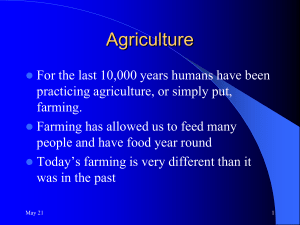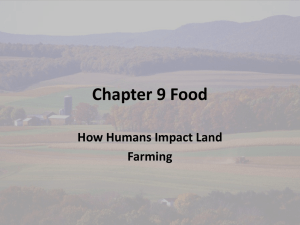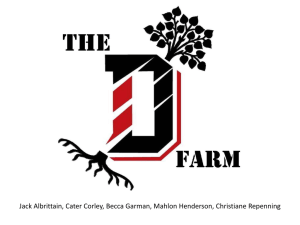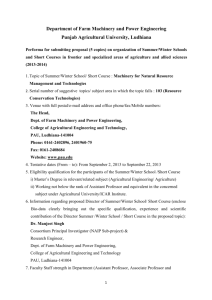lec 1
advertisement
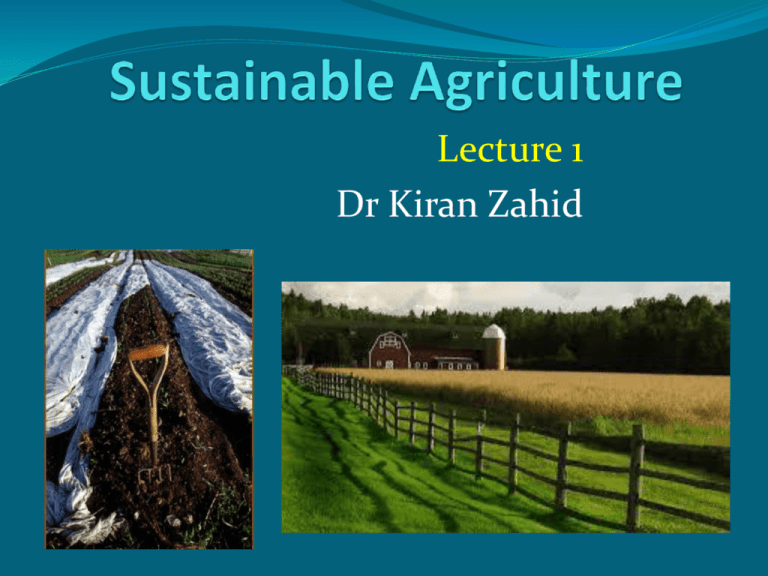
Lecture 1 Dr Kiran Zahid My background MSc. in Biotechnology [ University of Karachi (2005)] Research Fellowship [ KIBGE, University of Karachi (2005- 2007) Obtained Australian Endeavour Postgraduate Award (2007) PhD in Plant Biotechnology [ University of Wollongong & CSIRO, Plant Industry (2013)] Agriculture For the last 10,000 years humans have been practicing agriculture, or simply put, farming. Farming has allowed us to feed many people and have food year round. Today’s farming is very different than it was in the past. Traditional, or conventional, agriculture is how most of our food is made. It is large scale, industrial and designed to make the most amount of food with the smallest amount of space 4 What you think farming looks like… 5 What it really looks like… 6 Where are we? What are the Strengths and Weaknesses of our current agricultural system? 7 Successes abundant food supply in the developed world. fresh fruits and vegetables available year-round. cheap food. luxury foods such as coffee, tea, chocolate, and spices easily available around the world. effective food preservation technologies (refrigeration, freezing, canning, packaging). convenience foods. mechanization produces high labor efficiency. improvements in soil conservation. availability of agricultural inputs for quick solutions to production problems. 8 Problems continuing soil loss food safety concerns (mad cow disease, food poisoning outbreaks, antibiotic resistance, toxins and pesticides) water pollution, air pollution (& odors), habitat loss, water depletion continuing hunger – and rise of obesity failing farms, economic uncertainty and stress declining communities farm accidents, chronic diseases linked to agricultural chemicals reliance on fossil fuels, global warming farmland loss to development, ugly countryside difficulty of starting in farming 9 Wants and Needs There is a difference between human wants and human needs. Gandhi said that the world could surely provide for the needs of the many but not the greed of the few. Sustainable Agriculture Sustainability – Meeting needs without compromising future generations or providing for the NEEDS of ALL people alive today, without jeopardizing future generations Sustainable Agriculture – A commitment to satisfy human food and fiber needs and to enhance the quality of life for farmers and society as a whole, now and into the future. SUSTAINABLE AGRICULTURE Educational Objectives: This course is offered to familiarize the students with the concepts of sustainable farming that could save our environment and feed the world. It is necessary because many of our current agricultural practices are harmful to human health and the students must know about them before starting their careers in research or industry. Course outline The History and Development of Agriculture World food situation, hunger and malnutrition Environmental Quality and Human Health Issues in Modern Agriculture Energy use in agriculture Green revolution Climate change and its impact on food production Genetically engineered organisms in agriculture Soil as the basis of sustainable agriculture Deforestation Sustainable livestock based agricultural systems Pest management practices and sustainable agriculture The millennium development goals and different treaties on environmental protection Grading of the course Sessional 1 = 15/20 Sessional 2= 15/20 Final = 50 Assignments = 10/5 Final Project = 10/5 ----------------------------------------- Total = 100 My approach to teaching… The teaching sessions should be interactive….. Keep the students engaged and interested To be open to students concerns and suggestions… Try to incorporate updated information and modify lectures as per students requirements…… Remember….. Sustainable Agriculture Goals Meet human needs for food and fibre Protect the natural resource base and prevent the degradation of soil and water quality Use nonrenewable resources efficiently Use natural biological cycles and controls Assure the economic survival of farming and the well-being of farmers and their families Monocultures A monoculture is an area of land that only grows a large amount of one crop. This makes it very easy for pests to destroy the crops. As a result, pesticides are used. 22 Pesticides Pesticides damage soil and can run off into the surrounding area 23 Pesticides If a small amount of the pests survives and are resistant to the pesticide, then they will repopulate and a stronger, more toxic pesticide must be used. 24 Fertilizers Since the soil gets degraded quickly, fertilizers must be added to the soil. Fertilizer runoff causes “eutrophication” which means “too much of a good thing” because the added nutrients cause algae to flourish and choke out aquatic ecosystems 25 Integrates three main goals… 1. Environmental health 2. Economic profitability 3. Social & economic equity What if we lived our lives as if… A healthy economy only is possible within a healthy society…. and…. A healthy society is only possible within a healthy environment? Economically sustainable Provides a secure living for farm families Provides a secure living to other workers in the food system Provides access to good food for all 28 Borrow or repair? Keeping up with the neighbors Going Retail More Progress with Economic Sustainability 1. 2. 3. 4. 5. 6. Equipment is used and repaired Yields are good Govt. provides money for investment Interns can trade work for education Farm supports other farm businesses No waste Environmentally Sound Preserves the quality of soil, water, and air 32 Environmentally Sound Cooperates with and is modeled on natural systems 33 Biological fertilizer green manures for fertility Biological fertility Got Earthworms? Cows provide a bit more manure Renewable Energy Biodiesel fuel More Progress on Environmental Sustainability 1. Compost for fertility 2. Pastures to feed animals & soil 3. Cover crops used 4. Legumes for nitrogen 5. Windbreaks 6. Conservation tillage Socially sustainable Good for families Supports communities Fair to all involved 39 Sustainable farming…. …involve the neighbors! It takes a village…. Community Supported Agriculture Farm meetings…. ….involve the kids! More Progress with Social Sustainability 1. 2. 3. 4. 5. 6. 8. 9. 10. Donate food to the Food Bank Working with apprentices Pleasant environment Healthy employees Vacation time for family Simple living No machine noise Farm products stay local Supports neighbors Are we a sustainable society? Is agriculture economically viable? Well…. •1935 – 6.8 million farms • Today – 2.1 million farms with 1.3 million part time •McDonalds increased from 1000 restaurants in 1968 to 28,000 today, with 5 new ones each day •The suicide rate among farmers and ranchers is 3X national average in developed countries •Is it environmentally sound? Well… • Chemical fertilizer use has increased 10X since 1950 •The Dead Zone in the Gulf of Mexico from nitrogen fertilizer •Is it socially just? •Farm workers Health care •Meatpacking plant workers Injury rates •Fast food workers 3.5 million with a turnover rate of 300400%/yr And – lets look at the future … Population Water Soil Oil Water Shortages Today Major global problem areas And the big one! Humankind expends in one year an amount of fossil fuel that it took nature roughly a million years to produce. We are a non-sustainable society Food production, land use, water use etc. are part of a larger problem affecting every aspect of our lives, including: Energy use Waste handling Pollution Population and on and on….. This “seems” normal??? Natural Resources Goods and Services Pollution, Waste and Environmental Disturbances

